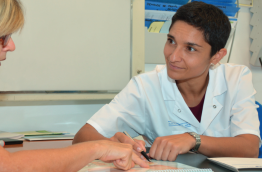
Breast Cancer: Towards Personalized Screenings
Interview with professor Catherine Uzan.

Today in France, one woman in eight is likely to develop breast cancer during her lifetime. However, if detected early, this cancer can be cured in 90% of cases.
For the 28th Pink October campaign, Prof. Catherine Uzan, head of the gynecological, breast surgery and oncology department at the Pitié-Salpêtrière Hospital, is reminding us of the importance of screening and the fight to improve patient care.
We talk about "the" breast cancer, but in reality there are several. How are they classified?
Catherine Uzan: We classify them according to their prognosis. The majority of them are discovered early on, thanks to screening, and have an excellent prognosis, with a cure rate of up to 92%. These are generally small cancers, hormone-sensitive and without lymph node involvement. Other, more aggressive cancers can progress more rapidly, but we have made a lot of progress in their management.
What are the main risk factors for breast cancer?
C. U.: There are two types of factors: those that we cannot control, such as family history, breast density, the environment in which we live (for example, there are more breast cancers in developed countries than in developing countries). Other factors are "actionable". This is the case, for example, with risk factors such as being overweight, smoking, diet or leading a sedentary lifestyle. It has been proven that practicing physical activity for 2.5 hours a week (which increases the heart rate and makes one sweat) reduces the risk of developing breast cancer and prevents the risk of recurrence.
How is breast cancer screened today?
C. U.: In France, we have one of the best organized and most accurate screening programs. It is offered free of charge every two years to all women between the ages of 50 and 74 and combines a clinical examination (palpation of the breasts) and a mammogram, the images of which are checked by two radiologists. When properly followed, this standardized screening enables the discovery of smaller tumors, less severe treatment and improved chance of survival.
Despite this, 50% of women do not participate, mainly because of the fear of overdiagnosis and overtreatment. There is a risk of detecting abnormalities that turn out to be benign or cancer that would not have caused any symptoms, sometimes leading to biopsies or cancer treatments that are not free of side effects. This is why it is important to continue to improve the quality of imaging, the standard of biopsy use, and the de-escalation of therapy when possible. New blood tests are being evaluated. But we must also continue to remind people that screening remains the best weapon for improving treatment.
Pink October
Each year, nearly 60,000 new cases of breast cancer are detected and about 12,000 women die from it. During the month of October, associations, doctors and volunteers take part in a campaign to inform and educate women about the best weapon of protection against this disease: early detection.
Consult the event program (in French) for October 7 at the Pitié-Salpêtrière Hospital, with support from the University Institute of Cancerology.
What innovations have you developed to improve breast cancer screening?
C. U.: We have coordinated the NOMAT01 study, the objective of which is to create a model to predict the presence of an associated cancer in the case of an atypical breast lesion during the biopsy in order to avoid surgery in patients for whom it would not be necessary. We also propose to take into account the tolerance of patients to living with uncertainty in order to identify those for whom simple surveillance could be more anxiety-provoking than the operation itself. The aim of this model is thus to identify all the clinical, biological, radiological and psychological criteria that will enable us to define the most appropriate therapeutic strategy for each patient.
With radiologist Prof. Isabelle Thomassin, we are also collaborating in the international clinical study MyPeBS (My Personal Breast Screening). Funded by the European Union and coordinated by Dr. Suzette Delaloge (Gustave Roussy), this study aims to compare the current standard of screening with a more personalized style of screening, according to the individual risk of each woman. In this latter model, patients, assessed over four years, are offered a different strategy depending on their risk level: for example, a mammogram every three years instead of every two years if the risk is low, or on the contrary, every year if the risk is high.
In 2018, you implemented the first risk assessment consultation dedicated to breast cancer in your department. Can you talk about its objectives?
C. U. : This consultation, implemented at Pitié-Salpêtrière under the aegis of the AP-HP-Sorbonne University Institute of Cancerology, is accessible to any woman wishing to learn about her breast cancer risk from the age of 18. Its objective is to allow a personalized screening according to individual risk by using evaluation models that take into account certain characteristics such as personal and family history, genetic factors, lifestyle, age of first menstruation, and breast density. During the consultation, we also work with the patient to identify the "actionable" risk factors by proposing personalized assistance (such as dietary, psychological, smoking consultation). Then we provide her with an adapted prevention plan including clinical follow-up, schedule of complementary examinations, information documents, proposal for consultation with an oncologist and hygienic and dietary advice.
In 2019, we received the Pink Ribbon Avenir award, which will allow us to go further by financing the AdDEPI project. In this study, we will contact patients again to see if they have implemented the proposed preventive measures (such as weight loss, smoking cessation, physical activity, radiological follow-up). We will then discuss with them how to improve compliance with these recommendations.
One of the challenges you face is also to continue to improve patient care, especially after cancer.
C. U.: Innovating in terms of patient care means not only making sure that the diagnosis is more accurate, but it also means accompanying patients before, during and after their treatment. As a surgeon, my surgical procedure is only one part of cancer management. Nurses do much of the essential work. The major development of outpatient care requires a lot of explanation before the operation; nurses have a privileged relationship with patients, explaining to them the course of treatment in the hospital, the support care at home and directing them to other specialists depending on their situation (fertility preservation, social workers, dieticians, tobacco specialists, psychologists).
The post-cancer period is now a major undertaking, particularly in terms of the fight against chronic fatigue, the psychological impact and the return to work. It is indeed important to be able to support patients towards an adapted and gradual return to work, for example with an adapted work schedule, rather than repeated work stoppages. We work with patient associations and patient-experts to achieve this.
Alongside Catherine Tourette-Turgis, who leads the University of Patients, we have, for example, set up the Café du rétablissement (the Recovery Café) at the Tenon and Pitié Salpêtrière hospitals. In this pilot program, patients are supported in their personal, existential and professional reconstruction process and meet with each other to exchange ideas. The hospital has a duty to provide guidance, but we will never be as effective as the patients themselves in answering everyday questions, as proven by Ms. Charlotte Pascal, currently in remission, through her book: Ma Meilleure amie a un cancer du sein, “My Best Friend Has Breast Cancer” (published by Flammarion), a small practical guide for patients and caregivers.
